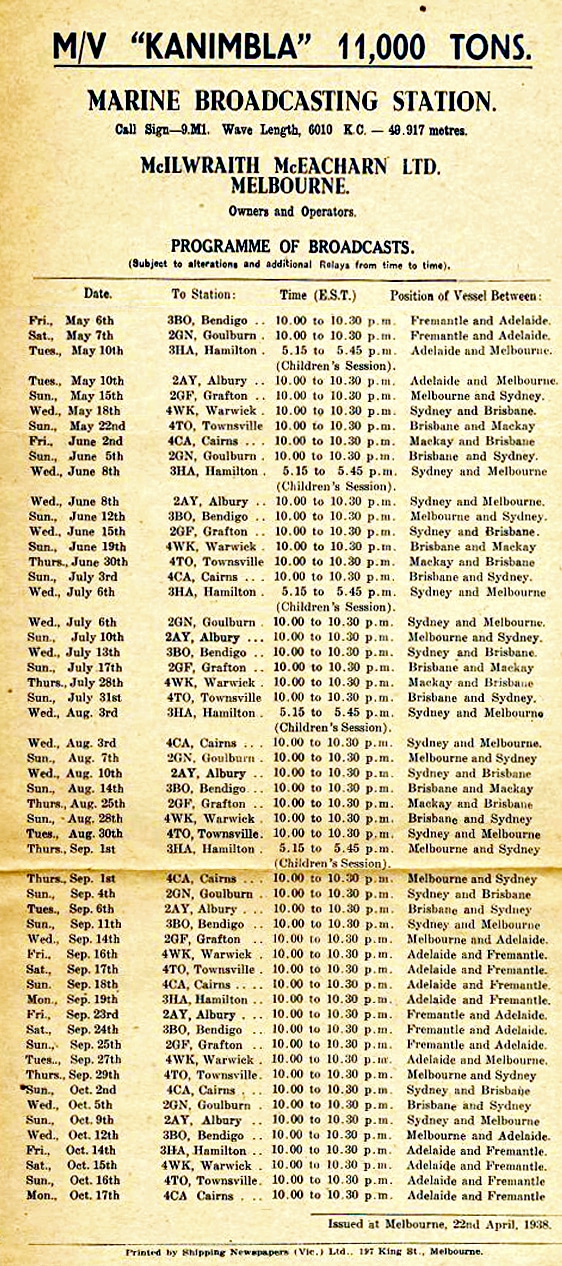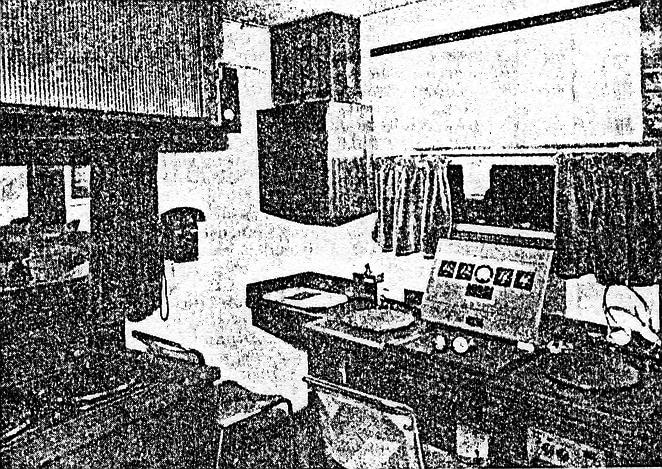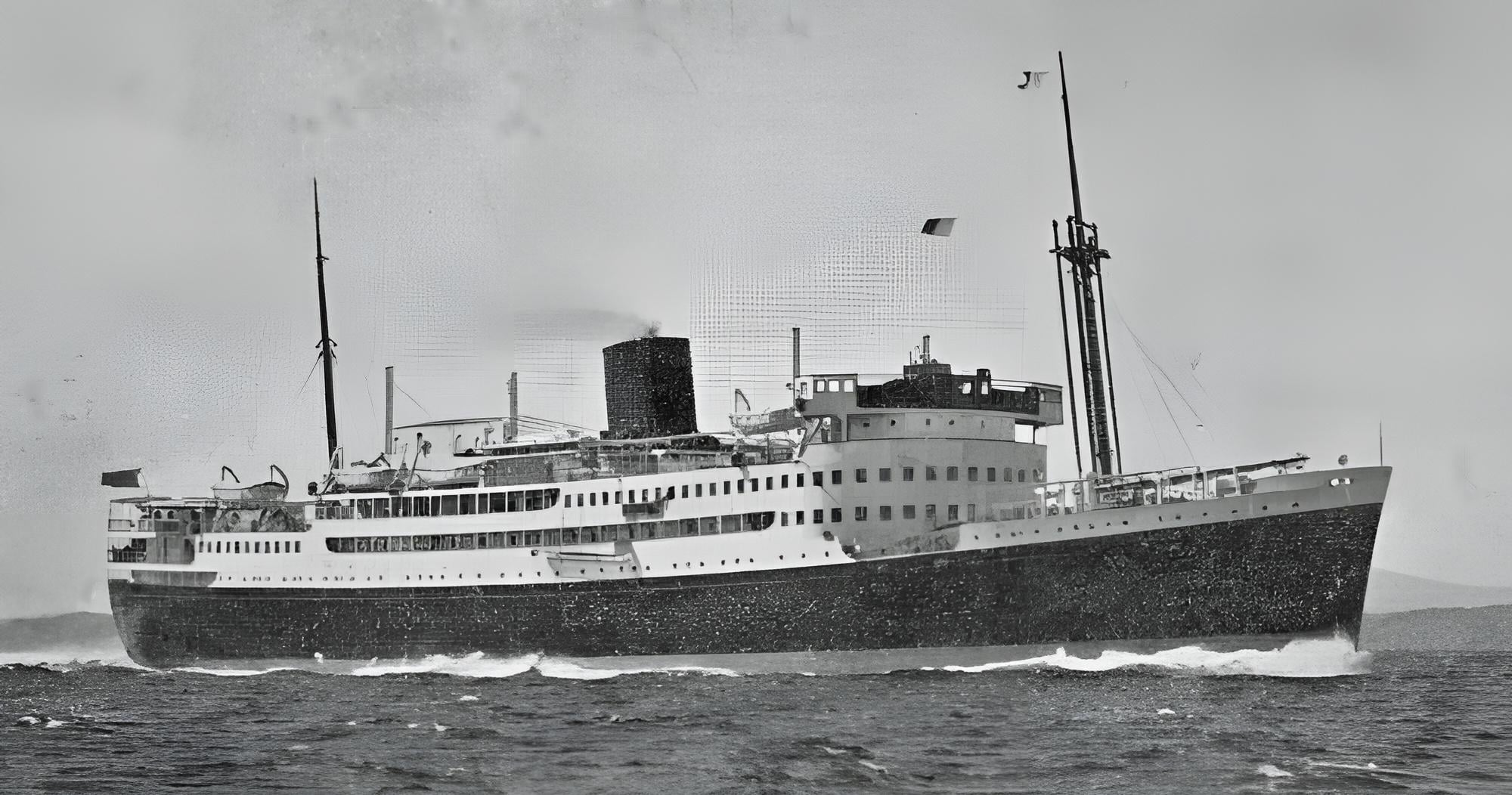Ship details:
| Tonnage: | 10985 tons gross |
| Complement: | 345 |
| Length: | 468.8 feet |
| Beam: | 66.3 feet |
| Draught: | 24.4 feet |
| Machinery: | Diesels Twin screws |
| Commissioned (RN): | 6 October 1939 |
| Commissioned (RAN): | 1 Jun 1943 |
| Laid Down: | July 1934 |
| Launched: | 15 December 1935 |
| Armament (Main): | As an armed merchant cruiser Seven 6 inch guns Two 3 inch AA guns 2 Lewis light machine guns As a LSI One 4 inch AA gun Two 4 0 mm Bofors AA guns Two 2 pounder AA guns Twelve 20mm Oerlikon AA guns |
| Builders: | Harland and Wolff Limited, Belfast |
| Completed: | 26 April 1936 |
| Speed: | 19 knots |
| Accommodation: | 1280 troops (as a LSI) |
The 10,985-ton twin screw motor vessel Kanimbla, built in Belfast in 1935 for McIlwraith, McEacharn was the last large passenger ship built specifically for Australian owners. The notable fact about the passenger liner Kanimbla is that it was the only ship in the entire history of our world in which a radio broadcasting station was constructed into the ship at the time when the ship was built. The electronic equipment was manufactured by AWA in Australia and shipped to Ireland for installation while the ship was still under construction. The “Kanimbla” plied with passenger traffic backwards and forwards on the southern route between Western Australia and Queensland, and the ports of call in this shuttle service were: Fremantle in Western Australia, Adelaide in South Australia, Melbourne in Victoria, Sydney in New South Wales and Brisbane & Mackay in Queensland.
Designed for 400 passengers, the vessel seemingly partnered the Manoora, west in summer and north in winter, but in 1939 was commissioned into the Royal Navy and sent to Hong Kong for refit as an armed merchant cruiser. In April 1943 she transferred to the RAN, converted to an infantry landing ship, and subsequently took part in all major landings in the South-West Pacific. Resuming the summer and winter schedule in 1950, the Kanimbla was sold in 1961 and broken up in 1974.

The “Kanimbla” was granted by the PMG Department in Australia a radio broadcasting license with the experimental callsign VK9MI. The radio station consisted of two studios; one for group broadcasts, and the other for announcer presentation. The crystal controlled transmitter was rated at 1.5 kW, though the QSL card states that the output into the antenna system was just 50 watts. This would seem to suggest that the original broadcast transmitter mal-functioned quite early and that the broadcast programs were then radiated from the ship’s communication transmitter. The original AWA transmitter could operate on any wavelength between 20 & 50 meters.
The first test broadcast from 9MI was made on April 21, 1936 during sea trials in the Firth of Clyde. The new MV “Kanimbla” began its delivery voyage from Northern Ireland to Australia at 4:00 am on April 26, 1936. It is reported that the radio station 9MI made four test broadcasts each day during this 15,000 mile journey to Australia.
The official inauguration of the new radio broadcasting station VK9MI was made in a special broadcast to Australia while the ship was south of the continent in the Great Australian Bight,1,000 miles from Sydney. At 8:00 pm Eastern Australian Standard Time, VK9MI went on the air shortwave and the program was picked up and relayed thoughout Australia over the ABC mediumwave network.
This inaugural broadcast from 9MI was made on 11720 kHz, though subsequently the regular channel was 6005 kHz, though this was modified in April 1939 to 6055 kHz. The at times irregular schedule from VK9MI was usually half an hour or an hour a few evenings a week. The announcer and manager was Eileen Foley, who also signed the QSL cards.
The local AWA mediumwave stations on land in each of these areas frequently relayed the shortwave programming from VK9MI to the local audience. Among these stations were 2AY in Albury New South Wales, 3BO in Bendigo Victoria, and 4CA in Cairns (pronounced as in air) Queensland.
On many occasions, radio station VK9MI was heard on shortwave throughout Australia and New Zealand, and many QSL cards were signed by the famous woman announcer, Eileen Foley. As time went by, the transmitter began to malfunction and it produced a noisy wide signal in the 49 meter band.
At the outbreak of the European War at the beginning of September 1939, the radio staton VK9MI was silenced. [Information by Dr. Adrian Peterson]
From the Australasian Radio World (July 1st 1936):
World’s First Ship Broadcast Station

Listeners To Have Novel Sea-to-Shore Programmes From New 11,000-Ton Passenger Liner, Kanimbla,
On May 28 last, Australian listeners heard on relay over the national network of stations the inaugural transmission from the first ship broadcast station in the world.
The programme came from the new 11,000 ton motor-vessel Kanimbla while she was several hum- dred miles off the Australian coast, on her maiden voyage to Sydney from the builders’ yards in Belfast. The Kanimbla is entering the Australian passen-ger service, and regular broadcasts will be given during voyages over 9MI–the call-sign issued to the new station.
The transmitter uses a power of 1.5 k.w., is crystal controlled, and is designed to operate on any wave- length between 20 and 50 metres, that used at present being 25.54. or 49.47 metres. The special studios (illustrated on this page) are replicas of those used by leading stations overseas.

Hundreds of Reports
The chief announcer is Miss Eileen Foley, of Sydney, who has already received hundreds of letters from listeners reporting ex- cellent reception from 9MI, both direct, on shortwave, and via the national stations. During the voyage out, while the Kanimbla was off the west coast of Africa, they test programmes were heard at good volume in Australia, Great Britain, and Europe, and so 9MI’s regular broadcasts will be picked up by listeners in over seas countries as well as in Australia.
For the entertainment of passengers, an extensive public address system has been installed. There are 14 loud-speakers in all, and no less than three differ ent programmes can be distributed throughout the ship at the same time. Some loudspeakers, for example, might be carrying sporting results.
Location: International waters off the Australian coast

